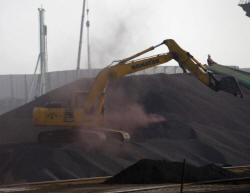How U.S. tariffs on China minerals could hurt industry,
consumers
 Send a link to a friend
Send a link to a friend
 [July 31, 2018]
By Tom Daly [July 31, 2018]
By Tom Daly
BEIJING (Reuters) - U.S. President Donald
Trump's proposed tariffs on another $200 billion of Chinese goods
threaten a niche trade in minor metals and rare earths used in
everything from stomach remedies and jet engines to consumer
electronics.
More than 6,000 items have been earmarked for a 10 percent import
tariff, including - in some form - 32 of the 35 minerals the United
States in May designated as "critical" to its economic and national
security.
These minerals and products based on them accounted for well over $1
billion of U.S. imports from China in 2017, and traders warn U.S.
consumers will end up paying a premium if tariffs are put in place,
albeit one cushioned by the recent devaluation of the yuan.
Below is a list of mineral products in the tariff list where the United
States relies heavily on China.
(GRAPHIC: U.S.-China minor metals and minerals -
https://tmsnrt.rs/2LwZWbE)

* Bismuth
No primary refined production of bismuth has taken place in the United
States since 1997. Applications for this white metal with a pinkish hue
range from stomach remedies to sprinkler systems, and China accounted
for 77 percent of U.S. bismuth imports over 2013-2016, according to the
United States Geological Survey (USGS). This includes waste and scrap
and totaled $22.8 million last year.
* Barite
Used as a weighting agent in oil and gas drilling, barite is another
mineral the United States mainly sources from China, which accounts for
69 percent of its imports. The value of these stood at $93.6 million
last year, when U.S. domestic barite mine production fell.
* Antimony
A shiny semi-metal used in fire retardants, antimony, together with its
powder form antimony oxide, accounted for $108.5 million of imports from
China last year. China provided 62 percent of antimony metal and 70
percent of antimony oxide imports from 2013-16, according to the USGS.
* Natural graphite
Long used in steelmaking and more recently as anode material for
lithium-ion batteries, natural graphite was not produced in the United
States last year. China is the top supplier, accounting for 35 percent
of imports over 2013-16, with a value of around $27 million in 2017,
although Mexico and Canada are alternative sources.
* Tungsten
Used to harden steel, Chinese tungsten items had an import value of
around $145 million last year. China, the world's top producer of the
metal, accounts for 34 percent of U.S. imports.
[to top of second column] |

A bulldozer and a labor work on a pile of iron ore at a steel
factory in Tangshan in China's Hebei Province November 3, 2015.
REUTERS/Kim Kyung-Hoon/File Photo

* Titanium
An element used in aerospace, titanium and titanium oxides had an import value
of $84.9 million in 2017, while there was an additional $89.1 million of
titanium dioxide pigment imports. China is a distant second to Japan with an 8
percent share of titanium sponge metal imports, but accounted for 24 percent of
imports of titanium dioxide, used as a pigment in paints.
* Tantalum
Used in capacitors for consumer electronics and in super-alloy castings for jet
engines, imports of tantalum items were worth $72.7 million last year. China
accounts for 23 percent of the various import sources but a trader reported
suppliers have been "really rushing" to ship in tantalum from China so it can
clear customs before possible tariffs in late August.
* Cobalt
Most mined cobalt supply comes from the Democratic Republic of Congo, but China
is a leading supplier of refined cobalt to the United States, according to the
USGS. Various forms of cobalt last year accounted for $65.3 million tonnes of
imports into the United States, where the main use is in super-alloys in
aircraft gas turbine engines. China provides 15 percent of U.S. supply, just
behind Norway.
* Rare earths
This group of 17 elements is used in magnets, consumer electronics, radars and
lasers. The USGS puts the value of U.S. rare-earth compounds and metal imports
last year at $150 million, with China making up 78 percent of imports over
2013-16. Separately, permanent magnets and articles intended to become permanent
magnets - which could include rare earth oxides neodymium and praseodymium -
accounted for $191 million of imports from China in 2017.

* Iron oxides and hydroxides
Iron oxide is mainly used as a pigment in construction materials. China provided
52 percent of the United States' synthetic iron oxide pigments (IOPs), according
to the USGS, which also notes, however, that "domestic and world resources for
production of IOPs are adequate." This category accounted for $94.6 million of
imports.
(Reporting by Tom Daly; editing by Richard Pullin)
[© 2018 Thomson Reuters. All rights
reserved.] Copyright 2018 Reuters. All rights reserved. This material may not be published,
broadcast, rewritten or redistributed.
Thompson Reuters is solely responsible for this content. |